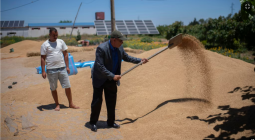Divert Dollars from Emission Cuts to Climate Preparedness, Adaptation Expert Says

This story includes details on the impacts of climate change that may be difficult for some readers. If you are feeling overwhelmed by this crisis situation here is a list of resources on how to cope with fears and feelings about the scope and pace of the climate crisis.
One of Canada’s foremost proponents of climate change adaptation says the “realpolitik” of limited government funding and a potential shift in federal policy prompted his recent call to divert funds from greenhouse gas emission reductions to pay for climate preparedness.
In a Globe and Mail op ed last week, Blair Feltmate, head of the University of Waterloo’s Intact Centre for Climate Adaptation, and the organization’s managing director for climate science, Anabela Bonada, pointed to a 22:1 ratio in federal funding for climate change mitigation and adaptation. That difference they wrote, “explains why funding for adaptation to counter extreme weather is in short supply. Canada must readjust climate financing to make funding for adaptation and mitigation more equitable.”
They added that “a reduction of 7% in GHG emissions, which consumes 95% of Canada’s climate budget, merits a rethink, particularly when considered against newly documented sources of GHG emissions from non-human activities.” That was a reference to the estimated 3,000 megatonnes of carbon pollution released during an epic wildfire season in 2023, a figure that far eclipsed the 708 megatonnes of industrial and consumer emissions the country produced in 2022 or the 53-megatonne reduction in annual emissions that it gradually accumulated between 2005 and 2022.
“If we can get new money to promote and fund adaptation, which currently is almost non-existent, that would be great,” Feltmate said in an interview. “In a perfect world, I would be quite happy if someone showed up with another giant pocketful of money.”
But “with the debt loads governments are carrying, it’s not going to happen, and by the way, I’m not guessing,” he added, citing recent meetings with key deputy ministers. “I was told categorically that if anybody who walks through their door with an ask that has a dollar sign attached to it, the answer is no, despite the return on investment. Because their marching orders are to reduce spending by 10 or 15%, period. So that’s where we are.”
That line of thought runs counter to the wider understanding among most climate practitioners and policy-makers that mitigation is a form of adaptation—that without faster, deeper emission cuts, climate change will accelerate beyond the point where human systems or infrastructure can adapt.
“Canada has warmed about 1.7°C on average in the past century, and what we’re seeing in terms of the destruction from extreme weather events and disasters indicates that we’re not prepared for this level of warming, let alone a higher global rise in temperature,” Ryan Ness, director of adaptation research at the Canadian Climate Institute, told The Energy Mix in an email.
So “choosing between adaptation to climate change or mitigation of emissions is a false choice—at this point, we need to do both,” Ness added. “Reducing emissions as swiftly as possible will help blunt the worst effects of climate change down the road, and investing in adaptation now will help to keep communities and people safe while reducing the economic drag of climate change. Our analysis indicates that reducing emissions and doing proactive adaptation at the same time is the most cost-effective option.”
‘No Turning Back’
Feltmate warned that “putting virtually no efforts into preparing for extreme weather risk is not serving us well,” echoing a concern the Climate Institute raised in its own assessment of federal financial backing for the National Adaptation Strategy. He cited flooding, wildfire, and heat as the three biggest climate risks Canadians currently face, adding that 1.5 million homes across the country are no longer insurable and that U.S. insurers in states like California and Washington are now refusing to offer fire coverage.
“If you take out fire insurance, it means you can’t get a mortgage, and that makes homes a stranded asset,” he said.
But he acknowledged that his own inclination to shift dollars out of mitigation was based on a sense of futility around the progression of the climate crisis.
“The reality is that we’re screwed,” he said. “There is no turning back, in my opinion. We’ve had it. All we’re doing now is damage control….lessening the damage. Because climate change is irreversible. The question is how much we can slow it down from business as usual.”
That view actually runs counter to recent chutes of optimism that oil and gas production are set to peak this decade, solar and wind have begun pushing fossil fuels off the grid, and that China’s world-leading emissions could begin to fall this year before going into structural decline, all prompting one U.S. atmospheric chemist to urge her colleagues not to give up when they’re on the cusp of success.
“You can’t look at the [plummeting] price of solar energy and batteries and not see big change coming,” Dr. Susan Solomon, professor of environmental studies and chemistry at the Massachusetts Institute of Technology (MIT), told The (UK) Observer. While some scientists are convinced average global warming is on its way past a devastating threshold of 3°C, that future “is very hard for me to see, because it’s pretty clear that the Paris agreement has already put us on a trajectory that won’t exceed that. Can we stay within 2°C, given how the prices of clean energy have come down? Personally, I think we can.”
There’s also some suggestion from climate science that decisive action on emissions would stabilize global temperatures over a span of three or four years, rather than three or four decades—but only if countries swiftly brought greenhouse gas emissions to zero.
‘Realpolitik’ and a New Government
While defunding emission reduction efforts wouldn’t pull in that direction, Feltmate said the “realpolitik” based on his own contact with senior government and corporate decision-makers is that “the cards on the table are different, and that’s simply the way it is.” With national polling pointing toward a change in government after the next federal election, he looked back on his past contact with former prime minister Stephen Harper for hints at the funding arguments a new team might be open to.
“They didn’t like discussions about climate change,” he recalled. “However, they did not want to see communities and homes flooded out. They did not want to see communities and homes burned down, and they did not want to see people unduly suffering due to extreme heat and potentially dying in extreme heat waves.”
So even if a future government is unwilling to follow the science and connect those risks back to climate change, “they can directly observe that these events are happening with greater frequency and intensity, and with more dire outcomes, and we should hopefully realize support to try to alleviate the amount of stress and cost in the system.”




